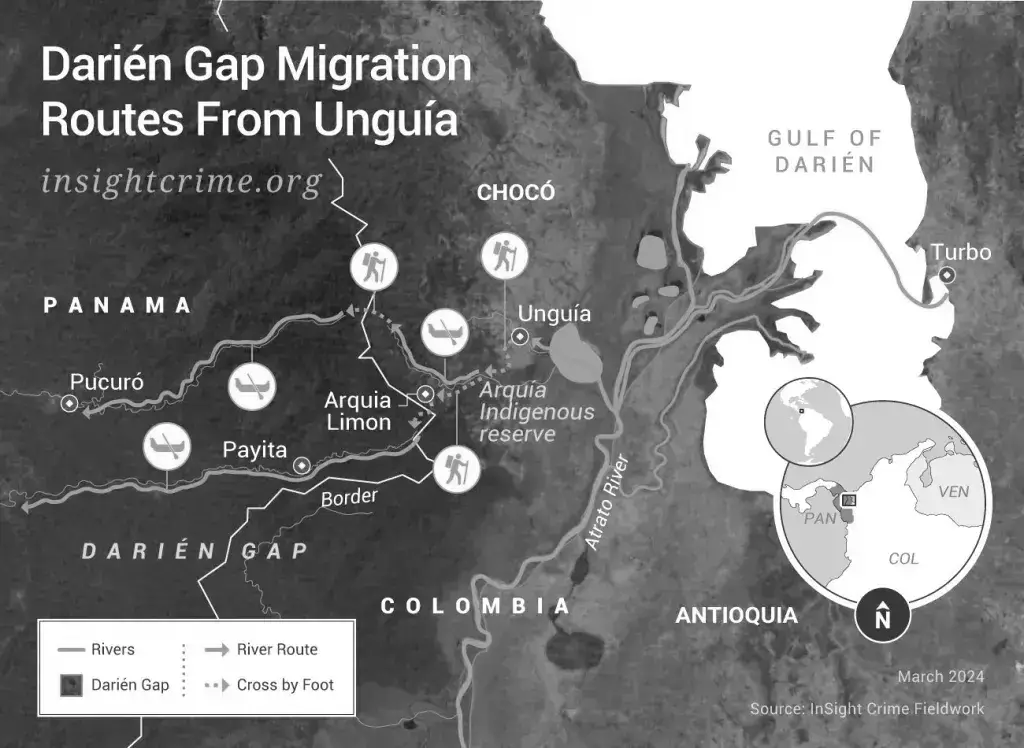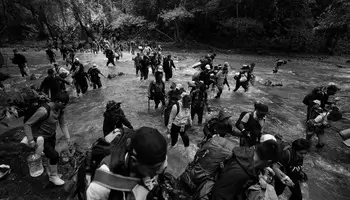Darién Gap Migration Reversal: AGC's Smuggling Empire Takes Economic Hit
Key Developments
- Migrant flows through Colombia's Darién Gap have dramatically reversed, with northbound crossings dropping from 37,000 in February 2023 to just 408 in February 2024 - a 99% decrease. This shift follows anticipated immigration policy changes under President Donald Trump's administration, forcing Colombia's dominant criminal organization, the Gaitanist Self-Defense Forces (AGC), to adapt their revenue streams.
- A new southbound migration pattern has emerged, with predominantly Venezuelan migrants abandoning their journey to the United States. Between January 15 and February 28, nearly 1,900 migrants arrived in Colombia from Panama, with daily arrivals exceeding 200 by March. This reversal is disrupting established smuggling networks but hasn't generated enough volume to replace the AGC's lost income from northbound operations.
The Collapse of a Criminal Corridor
The dramatic reduction in migrant traffic through the infamous Darién Gap jungle corridor marks a significant disruption to one of Latin America's most profitable criminal enterprises. What was once a thriving smuggling route generating between $17.5-25 million annually for the AGC has transformed into a shadow of its former self, compelling the powerful criminal organization to pivot toward alternative revenue sources.
Until recently, the treacherous 60-mile jungle passage between Colombia and Panama represented both humanitarian tragedy and criminal opportunity. Tens of thousands of migrants from across the globe - predominantly Venezuelans fleeing economic collapse - would pay smugglers controlled by the AGC to guide them through the dangerous terrain. By early 2024, however, anticipation of stricter US immigration policies following Donald Trump's election victory has dramatically altered this dynamic.

A Startling Statistical Reversal
The numbers tell a stark story. February 2024 saw just 408 migrants attempting the northbound crossing - compared to over 37,000 during the same month last year. This 99% decrease has sent shockwaves through local economies and criminal enterprises that had become dependent on migration flows.
More striking still is the reversal of migration patterns. Colombia's Foreign Ministry reports that 1,885 migrants - predominantly Venezuelans - arrived in Colombia from Panama between mid-January and late February. By March, this southbound flow accelerated to more than 200 daily arrivals. These migrants follow a complex route from Panama's Colón port to La Miel near the Colombian border, paying $230 per person for boat transportation. From there, they transfer to smaller vessels to reach Capurganá, Colombia, continue by motorcycle to Acandí, and finally take another boat to Necoclí - effectively traversing in reverse the route they once took northward.
Regional Migration Shifts
Meanwhile, Panamanian authorities report approximately 3,100 migrants entering from Costa Rica last week, suggesting this trend may represent a broader regional migration pattern shift rather than an isolated phenomenon.
"The economy of that area changed in recent years. An economic bubble was created that, when it burst, would bring a very bleak context," explained a government official working in the region who requested anonymity. "Now that bubble has burst, hurting many who formerly profited off migrants."
AGC's Criminal Business Model Under Pressure
For the AGC, this migration reversal threatens a critical revenue stream. The organization had established a near-monopoly on migrant smuggling through the region, extracting profits through two primary methods. First, they systematically extorted both formal and informal businesses connected to migration - hotels, guides, restaurants, stores, and transporters all paid "taxes" to the criminal group. Second, the AGC earned direct profits by facilitating migrant movement through territories under their control.
The combined income from these operations had become substantial. According to InSight Crime's analysis, by 2023 the AGC was earning between $17.5-25 million annually from migration-related activities in the Darién region. This revenue stream helped finance the group's ongoing territorial war against their primary rival, the National Liberation Army (ELN), particularly in the strategic Chocó department south of Urabá.
Southbound Flow: Insufficient Replacement
While some might expect the AGC to capitalize on southbound migration flows, security experts suggest these numbers remain too small to replace lost income. "These are very small flows. From a business perspective, which is what these groups always see, it's not an attractive phenomenon for them," noted the anonymous government official.

Criminal Adaptation Strategies
Faced with diminishing returns from migration, the AGC appears to be adapting its criminal portfolio. Local sources report the organization is intensifying "collaboration" - their euphemism for extortion - with other economic sectors, particularly cattle ranchers. This diversification strategy reflects the group's need for consistent income to sustain operations and territorial control.
The revenue shortfall will likely drive the AGC to refocus on drug trafficking through the Darién and Colombia's Urabá region - historically the group's most profitable criminal enterprise and territorial stronghold. This strategic pivot could intensify violence in contested areas as the organization seeks to consolidate control over lucrative trafficking corridors.
US Policy Ripple Effects
The migration reversal also highlights the interconnectedness of US policy decisions and transnational criminal dynamics. The mere anticipation of stricter immigration enforcement under the Trump administration has triggered dramatic changes in migration patterns, criminal economies, and local livelihoods throughout the region.
Economic Impact on Border Communities
For communities along the migration route, the economic impact has been severe. Towns like Necoclí that had developed economies catering to northbound migrants now face economic contraction. Hotels, restaurants, transportation services, and various informal businesses that flourished during peak migration periods have seen revenues plummet as migration flows dried up.
A Fluid Situation
The current situation remains fluid, with migration patterns potentially shifting again as regional policies evolve. However, the dramatic reduction in Darién crossings represents a significant disruption to established criminal economies that had become entrenched in the region.
Security Implications
For security forces and policymakers, the migration slowdown presents both opportunities and challenges. While reduced migrant flows might diminish humanitarian concerns in the dangerous jungle corridor, the AGC's pivot to alternative revenue sources could intensify extortion and violence against local populations. Additionally, renewed focus on drug trafficking could increase cocaine shipments through the region.
Criminal Resilience and Adaptation
The AGC's ability to adapt to changing circumstances underscores the resilience of transnational criminal organizations in the face of shifting economic and political landscapes. Rather than eliminating criminal activity, the migration decline has merely redirected it - potentially concentrating the group's focus on even more destructive enterprises.
As migration patterns continue to evolve across the Americas, understanding these criminal adaptations becomes crucial for developing effective security and humanitarian responses. The situation in the Darién Gap serves as a case study in how external policy changes can reshape criminal economies, often with unintended consequences for regional security and local communities.
For now, the once-bustling migration route through one of the world's most dangerous jungles has fallen quiet - but the criminal organizations that profited from human suffering continue to adapt, evolve, and seek new opportunities in an ever-changing landscape of transnational crime.